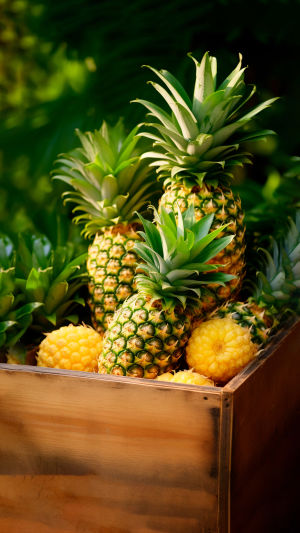Pineapple plants, part of the Bromeliaceae family, have special ways of growing and reproducing that set them apart from many other fruit plants.
Understanding how they grow helps us see why this tropical fruit does so well.
<h3>How Pineapple Plants Grow</h3>
Pineapple plants are herbaceous perennials, which means they live for several years and have soft, green parts instead of woody stems. They usually grow to a height of about 1 to 1.5 meters (3 to 5 feet). The plant has a central stem surrounded by long, sword-shaped leaves that can also grow up to 1.5 meters long. The plant starts by forming a circle of leaves around the central stem, a common feature of bromeliads.
<h3>Flowering and Fruit Development</h3>
After 12 to 20 months, when the plant is mature, it grows a flower stalk from the center. This stalk has a cluster of small, tube-shaped flowers—up to 200 of them—which come together to form the pineapple fruit. The flowering stage is important because it leads to the fruit's development. It usually takes about five months for the fruit to ripen after the flowers fall off.
The fruit starts green and slowly turns yellow-orange as it ripens, which means it's ready to pick. In commercial farming, pineapples are often harvested while still green to make shipping easier, though this can affect how sweet and flavorful they are.
<h3>How Pineapple Plants Reproduce</h3>
Pineapples mostly reproduce by growing new plants from parts of the existing plant, rather than from seeds. There are several ways this can happen:
<b>1. Crown Planting</b>
The leafy top of the pineapple called the crown, can be planted in soil to grow a new plant. This is a simple method often used by gardeners to propagate more pineapples.
<b>2. Slips and Suckers</b>
<b>Slips:</b> These are small shoots that grow from the flower stalk below the fruit. They can be removed and planted to start new plants.
<b>Suckers:</b> These are side shoots that grow from the main stem's leaf axils (the space where the leaf meets the stem). They can also be taken off and planted to grow new plants.
<b>3. Seed Production</b>
While most commercial pineapples are seedless because their flowers can't fertilize themselves (a process known as self-incompatibility), pineapples can produce seeds if they are pollinated by a different variety of pineapple. This usually requires pollinators like hummingbirds. However, in farms, pollination is often controlled to prevent seeds from forming because seeds can lower the quality of the fruit.
In short, pineapple plants grow mainly through vegetative propagation, with seed production being less common. Their unique ways of growing and reproducing make them interesting for both commercial farming and home gardening.





